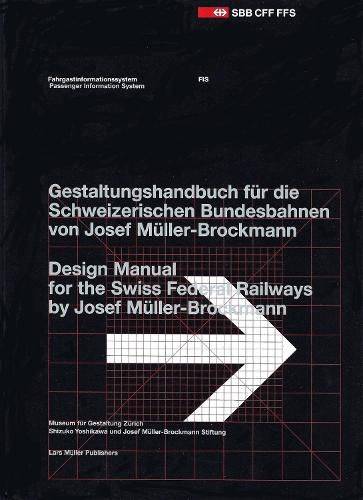Readings Newsletter
Become a Readings Member to make your shopping experience even easier.
Sign in or sign up for free!
You’re not far away from qualifying for FREE standard shipping within Australia
You’ve qualified for FREE standard shipping within Australia
The cart is loading…






A facsimile edition of the world-famous design manual for the Swiss Federal Railways' iconic and unique pictogram signage system. In 1980, famed Swiss graphic designer Josef Mu?ller-Brockmann (1914?96) laid the cornerstone for a uniform visual identity for the Swiss Federal Railways with his legendary Visual Information System at Train Stations and Stops. Because of Switzerland's multilingualism, the manual proposed a signage system that largely excluded language. With his functional typography, Mu?ller-Brockmann conceived an intuitively comprehensible signage system for use throughout the country to guide passengers with the help of pictograms. Mu?ller-Brockmann's manual, greatly expanded in 1992, is a prime example of a complex design project that succeeds through extreme rationality and consistency. This complete English translation makes the manual accessible for the first time to a broader public. Andres Janser examines the project in the context of Mu?ller-Brockmann's conceptual work and the systematic international design for which railways everywhere were striving during the period. AUTHOR: As a teacher in Japan and at the design schools in Zurich and Ulm, as well as a lecturer and consultant, Josef Mueller-Brockmann was a distinctive voice in the design world. His posters are legendary and his magazine New Graphic Design (1958?65) spread the doctrine of sober design based on constructive principles across the continents. SELLING POINTS: . Josef Mueller-Brockmann was a leading figure in Swiss graphic design. Beginning in the 1950s, he helped to pioneer the Swiss Style that would shape graphic design worldwide for decades. In 1980 he designed the signage system for the Swiss Federal Railways, unique in its near-total absence of language and reliance on universally understood symbols and pictograms. . Facsimile reprint of the 1992 Passenger Information System manual that later became a signpost for successful graphic design systems. Now available in a complete English translation with introductory essays.
$9.00 standard shipping within Australia
FREE standard shipping within Australia for orders over $100.00
Express & International shipping calculated at checkout
Stock availability can be subject to change without notice. We recommend calling the shop or contacting our online team to check availability of low stock items. Please see our Shopping Online page for more details.
A facsimile edition of the world-famous design manual for the Swiss Federal Railways' iconic and unique pictogram signage system. In 1980, famed Swiss graphic designer Josef Mu?ller-Brockmann (1914?96) laid the cornerstone for a uniform visual identity for the Swiss Federal Railways with his legendary Visual Information System at Train Stations and Stops. Because of Switzerland's multilingualism, the manual proposed a signage system that largely excluded language. With his functional typography, Mu?ller-Brockmann conceived an intuitively comprehensible signage system for use throughout the country to guide passengers with the help of pictograms. Mu?ller-Brockmann's manual, greatly expanded in 1992, is a prime example of a complex design project that succeeds through extreme rationality and consistency. This complete English translation makes the manual accessible for the first time to a broader public. Andres Janser examines the project in the context of Mu?ller-Brockmann's conceptual work and the systematic international design for which railways everywhere were striving during the period. AUTHOR: As a teacher in Japan and at the design schools in Zurich and Ulm, as well as a lecturer and consultant, Josef Mueller-Brockmann was a distinctive voice in the design world. His posters are legendary and his magazine New Graphic Design (1958?65) spread the doctrine of sober design based on constructive principles across the continents. SELLING POINTS: . Josef Mueller-Brockmann was a leading figure in Swiss graphic design. Beginning in the 1950s, he helped to pioneer the Swiss Style that would shape graphic design worldwide for decades. In 1980 he designed the signage system for the Swiss Federal Railways, unique in its near-total absence of language and reliance on universally understood symbols and pictograms. . Facsimile reprint of the 1992 Passenger Information System manual that later became a signpost for successful graphic design systems. Now available in a complete English translation with introductory essays.